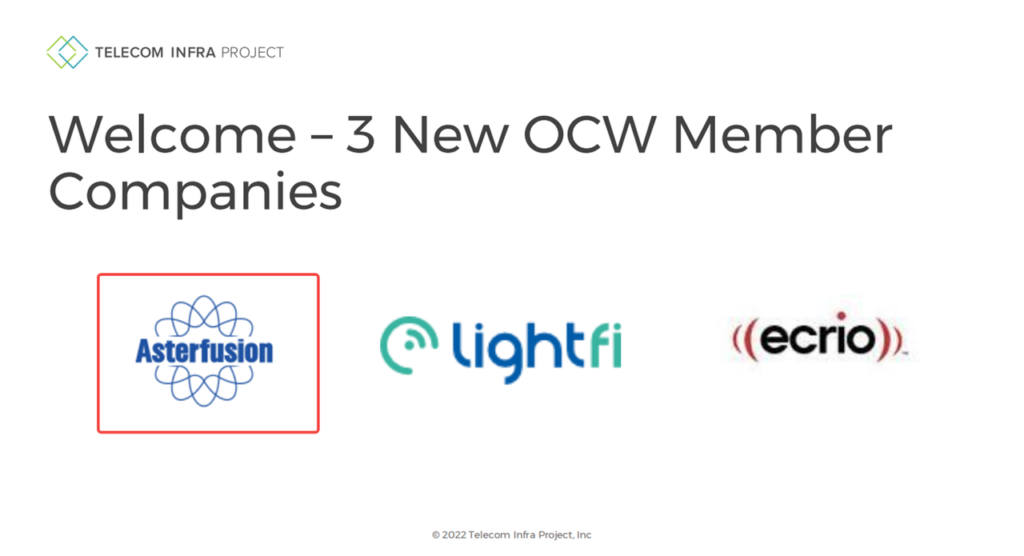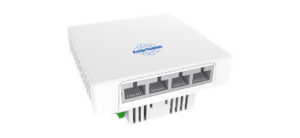Table of Contents
Asterfusion joined the Telecommunications Infrastructure Project (TIP) Open Converged Wireless (OCW) project team in April 2023 and has built our TIP-based OpenWiFi Controller that can easily and effectively managed our SONiC NOS-based layer2/3 switches .
Next, let’s explore what the open wifi project is and why we join it.
What is Open-WiFi
Introduced in 2021, OpenWiFi is an initiative of the Open Converged Wireless (OCW) software project group under the Telecommunications Infrastructure Project (TIP). It has evolved from previous TIP efforts like OpenRAN, Open Optical, and Packet Transport (OOPT). It’s a collaborative and open-source Wi-Fi software platform developed by the community. It consists of a cloud controller SDK and high-quality access point (AP) firmware that seamlessly work together.
Why OpenWiFi?
By using OpenWiFi, businesses can reduce the cost of developing and managing Wi-Fi networks, allowing for faster and more innovative operations. Unlike the traditional approach where each service provider or OEM builds a Wi-Fi stack from scratch, OpenWiFi offers a pre-built stack and certified hardware, saving time and resources. Additionally, OpenWiFi provides open APIs for efficient device management through the cloud.
Since OpenWrt and DD-WRT already exist as open source projects, you might be wondering why there is a need for OpenWiFi. Let’s take a closer look at the distinctions between these three projects.
What sets OpenWiFi apart from OpenWrt & DD-WRT?
OpenWrt is a customizable and community-driven Linux-based firmware designed for wireless routers and embedded devices. It offers an alternative to the proprietary software provided by router manufacturers, allowing users to have more control over their routers and offering a wide range of features and packages for installation and configuration. With support for various router models and extensive customization options, OpenWrt is highly popular among advanced users and developers.
DD-WRT is also an open-source firmware project for wireless routers, based on the Linux kernel. Like OpenWrt, it provides an alternative firmware option for a variety of router models. However, DD-WRT emphasizes user-friendly features and extensive compatibility. It offers advanced networking capabilities, VPN support, QoS (Quality of Service) settings, and more. Thanks to its intuitive interface and wide range of router model compatibility, DD-WRT is often preferred by users seeking additional features and customization beyond what the manufacturer’s firmware provides.
OpenWiFi aims to create an open and disaggregated Wi-Fi system architecture, fostering innovation, flexibility, and interoperability in wireless networks. This project focuses on developing open-source software and hardware designs for Wi-Fi access points and controllers, providing a framework for customizable and scalable Wi-Fi solutions. It prioritizes the concept of openness within the Wi-Fi ecosystem. It utilizes OpenWrt and embraces all stakeholders, including corporations, industry alliances, and open-source communities. This project allows the usage of a single codebase on any compliant whitebox hardware. Additionally, a standardized open API enables access points to be managed from the cloud. Application developers can utilize this API to create innovative services on the cloud while targeting any device running on the OpenWiFi stack.
In summary, OpenWiFi focuses on creating an open and disaggregated Wi-Fi system architecture, while OpenWrt and DD-WRT are open-source firmware projects that offer alternative firmware options for wireless routers.
what is OpenWiFi stack?
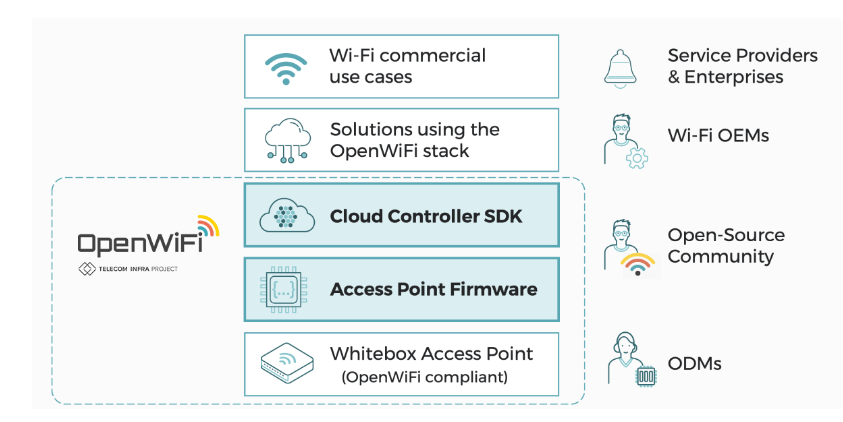
The OpenWiFi stack, which is the software technology stack used in the OpenWiFi project, includes advanced features for enterprises and carriers. These features consist of open and standardized APIs and data models for access points and controllers, as well as scalable mobility and Wi-Fi meshing, extensible Radio Resource Management (RRM), Passpoint (802.11u) and OpenRoaming, configuration, telemetry, analytics, and more.
The main goal of the OpenWiFi stack is to provide a flexible and customizable Wi-Fi system architecture that promotes innovation, interoperability, and automation in wireless networks. It enables the development of commercial solutions for Wireless LAN as a Service (WLANaaS), automation driven by machine learning, advanced analytics, and device security.
By utilizing the OpenWiFi stack, enterprises can focus on innovating their services rather than dealing with the underlying Wi-Fi stack itself. This enables them to freely choose cloud controllers and access points from various vendors, avoiding vendor lock-in and providing flexibility and choice to service providers.
Advanteges of OpenWiFi encompass several aspects:
- Reduced R&D Expenses: OpenWiFi effectively reduces the costs associated with developing enterprise-grade Wi-Fi solutions. By leveraging the open source codebase and compliance testing, Wi-Fi solution providers can decrease their research and development expenditures without compromising on the latest advancements and innovations in Wi-Fi technology.
- Enhanced Flexibility and Customization: OpenWiFi allows for greater flexibility and customization in deploying Wi-Fi networks. The open-source nature of OpenWiFi enables users to access and modify the source code, making it easier to tailor the Wi-Fi solution to specific requirements and seamlessly integrate it with other systems or applications.
- Promotion of Interoperability: OpenWiFi fosters interoperability within the Wi-Fi ecosystem. It brings together corporations, industry alliances, and open-source communities, facilitating collaboration and standardization. Utilizing a single codebase that is compatible with compliant whitebox hardware, OpenWiFi ensures compatibility and seamless integration across diverse devices and vendors.
- Encouragement of Innovation and Market Entry: OpenWiFi lowers the barriers to entry for new service providers in the Wi-Fi market. By offering an open and accessible platform, OpenWiFi encourages innovation and the development of new services and applications built on top of the OpenWiFi stack. This stimulates competition and drives the introduction of fresh ideas and solutions.
- Continuous Updates and Community Support: OpenWiFi benefits from a dynamic and engaged community of developers and contributors. This community-driven approach guarantees continuous updates, enhancements, and support for the OpenWiFi platform. Enterprises can derive value from the latest advancements, bug fixes, and security updates generated within the OpenWiFi community.
Asterfusion OpenWiFi Controller, LAN switching + SONiC NOS-based open campus Switching
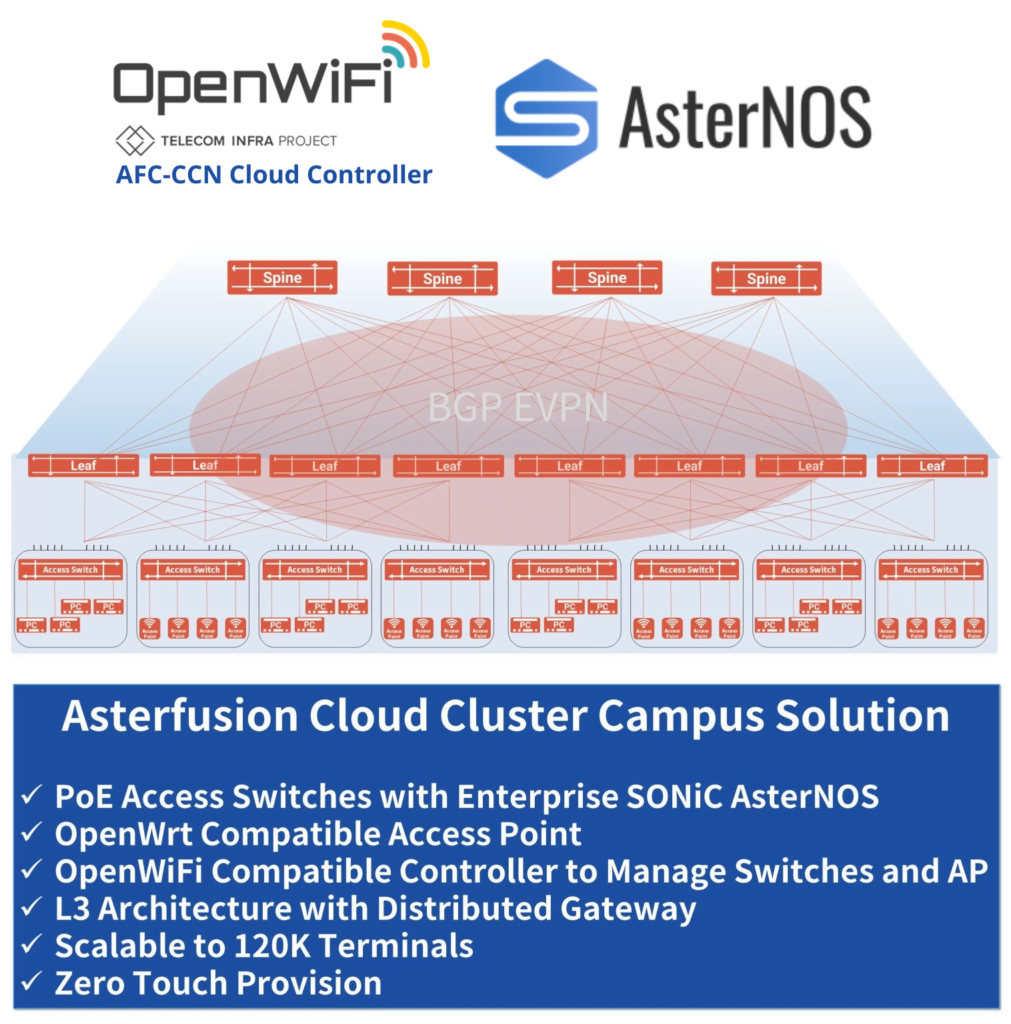
We are excited to announce that Asterfusion’s SONiC NOS-based layer2/3 switches can now be effortlessly managed through our TIP-based Open WiFi Controller-AFC CCN cloud controller! Taking the overall management experience to the next level.
For more: https://cloudswit.ch/asterfusion-launches-tip-openwifi-cloud-controller-afc-ccn-cloud-controller/
Our innovative campus solution incorporates full-size SONiC NOS on dual A53 processors within our PoEswitch. This means seamless ZTP for hundreds of switches and WiFi APs, all from a dual-core EC2 instance. With the Asterfusion Cloud Cluster Architecture, we deliver a robust, scalable, and turnkey campus access switching solution. It’s all based on SONiC NOS and fully compatible with OpenWiFi technology.
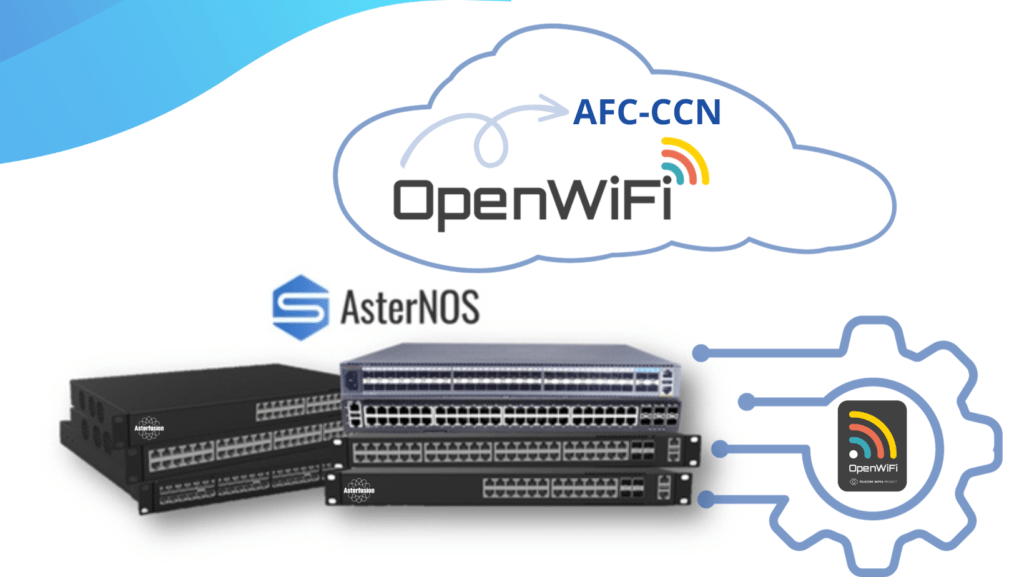
In Q4 we will release our SONiC-based wired+ open wifi-based wireless solution, so stay tuned!
Related Products
